Saab JAS 39 Gripen
Role: multi-role fighter
Builder: Saab Aerospace
Variants: JAS 39A, JAS 39B, JAS 39C, JAS 39D, JAS 39NG, JAS 39E, JAS 39F
Operators: Sweden, Brazil, Czech Republic, Hungary, South Africa, Thailand, (United Kingdom ETPS)
The JAS 39 Gripen is a small, agile and lightweight fighter design for multiple roles in the Royal Swedish Air Force. JAS stands for Jagt-Attack-Spaning which means Fighter-Attack-Reconnaissance. The Gripen (Griffon) design features canards positioned close in front of the delta wing. It is powered by the Volvo license-built General Electric F404-GE-400 engine modified for Gripen. The airframe structure incorporates light but extremely strong composite materials. It has a modern glass cockpit with three multi function displays and a wide-angle HUD. Its easily programmable software and associated systems make the aircraft suitable to configure it for all kinds of mission profiles.
The JAS 39A single-seaters were the first production aircraft to enter service in the Swedish Air Force in 1997. Batch 2 saw the addition of the JAS 39B two-seaters and the improved JAS 39C single-seater, both developed in response to NATO inter-operability and export market needs. Batch 3 order produced the the JAS 39C and two-seat version JAS 39D. Improvements include air-to-air refuelling capability, NATO weapon pylons, and NATO compatible systems. After 2004 Swedish A/B variants were to be upgraded to Batch 3 (C/D) standard, the resulting conversion however meant scrapping the airframe and re-use the components on new build JAS 39C/D airframes. As the Swedish Air Force had a surplus of JAS 39A versions, it was possible to use the cockpit seats and components from two JAS 39A aircraft to build one JAS 39D. The more limited number of JAS 39B two-seaters were not converted, but continued to serve the training wing which also trained foreign pilots. The UK Empire Test Pilot School also leases three JAS 39B.
Export customers for the JAS 39C/D were found in South Africa, Czech Republic, Hungary and Thailand. South Africa was the first
foreign customer for the Gripen, ordering 19 JAS 39C and nine JAS 39D twin-seat aircraft in 1999. Later the order was reduced to 26 aircraft,
cutting the number of single-seater down to 17. The aircraft were delivered from 2007 onwards and replaced the Cheetah C/D.
In 2003 Hungary signed a lease-and-purchase contract for 12 single-seat and 2 twin-seat aircraft to be
delivered in 2006 and 2007. The contract consists of a 10 year lease after which the aircraft will be
property of the Hungarian government in 2016.
In 2004 the Czech Republic signed a lease contract for twelve single-seat and two twin-seat Gripen aircraft
for a period of 10 years. The aircraft were diverted from the production line destined for the Swedish Air Force
for reduced delivery times. The first Czech Gripen made its first flight in November 2004 and was delivered
to the Czech Air Force in April 2005, making the Czech Republic the first NATO operator of the type. The last
aircraft followed in August 2005. The JAS 39 C/D is fully NATO compliant and filled the gap in the
Czech air defence after the MiG-23/29 disposal and MiG-21 retirement. In September 2013, a new lease contract
was negotiated for the 14 Gripens, which included upgrading the fleet to the latest software configuration,
adding the Link16 data-link. In March 2014, followed by the May 2014 signing, the lease extension was approved by
the Czech government for the next 12 years.
BAE Systems had bought a stake in Saab Aerospace, the Saab-BAE Systems consortium known as Gripen International tried to find more export customers. The Gripen was also offered to Poland to fill its requirement for 48 fourth generation fighter aircraft, but Lockheed Martin's F-16C/D Block 52 fighter was the winner. Austria selected the Eurofighter Typhoon over the Gripen. The Gripen International also lost potential export sales due to countries opting to postpone their next generation fighter selection in light of the Joint Strike Fighter (JSF). BAE Systems later sold back its share.
Thailand became the latest customer for the Gripen C/D following a deal with the Swedish Government for an air defence solution combining Gripen with the Saab 340 Erieye AEW&C aircraft. The first order signed in 2008 for six Gripens was followed by a second order in 2010 for six more. The Royal Thai Air Force (RTAF) took delivery of the eight JAS 39C and four JAS 39D from 2011 to 2013. The RTAF operates the Gripen in the air defence role for the southern part of the country, while it continues to operate its mixed fleet of F-16, F-5 and Alpha Jets. Thailand has also procuded the RBS 15 anti-ship missile to give the Gripen an anti-surface warfare capability as their area of responsibility includes the Andaman Sea and the Gulf of Thailand.
Saab Aerospace meanwhile continued to market the Gripen to other countries and together with the Swedish Air Force and FMV established the potential for an improved Gripen variant. Announced in June 2007, the Gripen Next Generation project gave rise to the third generation. Dubbed Gripen NG, the demonstrator aircraft converted from a JAS 39D two-seater features a redesigned airframe to fit the more powerful F414G powerplant and move the main gear outwards to increase internal fuel capacity and additional under-fuselage hardpoints. Additionally the aircraft's suite of avionics and sensors will be upgraded, the main component being the Raven ES-05 AESA radar.
The new Gripen NG was first selected by the Swiss Air Force as F-5E/F Tiger II replacement, but as a result of a 2014 referendum the Swiss government could not go ahead with a firm contract. However the Swedish government has meanwhile funded the research and development of the Gripen NG and in December 2013 a production order was signed to convert 60 JAS 39C to JAS 39E with first deliveries in 2018. The next success for the Gripen NG came around the same time when Brazil opted for the Gripen NG for its F-X2 requirement. The selection of the Gripen is primarily attributed to the potential technology transfer and lower procurement and life-cycle costs compared to alternative fighters. While the contract is still under negotiation, Brazil is looking for 36 aircraft, 28 Gripen E and eight two-seat Gripen F. The deal could include an interim solution in the form of second-hand JAS 39C aircraft, however upgraded F-5EM have already taken over the air defence role following the expiration of the Mirage 2000C lease.
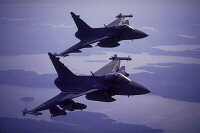
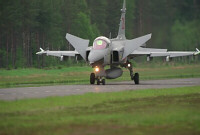
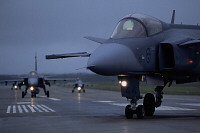
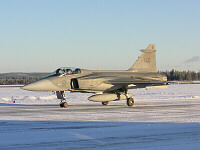
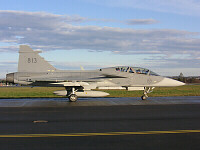

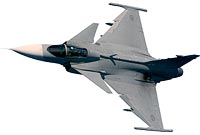
 Back to Index
Back to Index